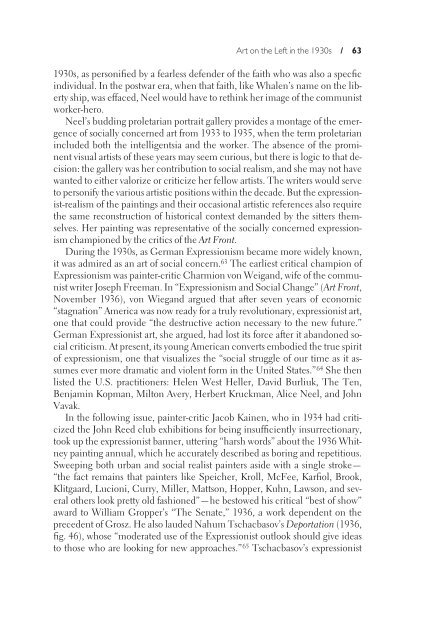i-xxii Front matter.qxd - Brandeis Institutional Repository
i-xxii Front matter.qxd - Brandeis Institutional Repository
i-xxii Front matter.qxd - Brandeis Institutional Repository
Create successful ePaper yourself
Turn your PDF publications into a flip-book with our unique Google optimized e-Paper software.
Art on the Left in the 1930s / 631930s, as personiƒed by a fearless defender of the faith who was also a specƒcindividual. In the postwar era, when that faith, like Whalen’s name on the libertyship, was effaced, Neel would have to rethink her image of the communistworker-hero.Neel’s budding proletarian portrait gallery provides a montage of the emergenceof socially concerned art from 1933 to 1935, when the term proletarianincluded both the intelligentsia and the worker. The absence of the prominentvisual artists of these years may seem curious, but there is logic to that decision:the gallery was her contribution to social realism, and she may not havewanted to either valorize or criticize her fellow artists. The writers would serveto personify the various artistic positions within the decade. But the expressionist-realismof the paintings and their occasional artistic references also requirethe same reconstruction of historical context demanded by the sitters themselves.Her painting was representative of the socially concerned expressionismchampioned by the critics of the Art <strong>Front</strong>.During the 1930s, as German Expressionism became more widely known,it was admired as an art of social concern. 63 The earliest critical champion ofExpressionism was painter-critic Charmion von Weigand, wife of the communistwriter Joseph Freeman. In “Expressionism and Social Change” (Art <strong>Front</strong>,November 1936), von Wiegand argued that after seven years of economic“stagnation” America was now ready for a truly revolutionary, expressionist art,one that could provide “the destructive action necessary to the new future.”German Expressionist art, she argued, had lost its force after it abandoned socialcriticism. At present, its young American converts embodied the true spiritof expressionism, one that visualizes the “social struggle of our time as it assumesever more dramatic and violent form in the United States.” 64 She thenlisted the U.S. practitioners: Helen West Heller, David Burliuk, The Ten,Benjamin Kopman, Milton Avery, Herbert Kruckman, Alice Neel, and JohnVavak.In the following issue, painter-critic Jacob Kainen, who in 1934 had criticizedthe John Reed club exhibitions for being insufƒciently insurrectionary,took up the expressionist banner, uttering “harsh words” about the 1936 Whitneypainting annual, which he accurately described as boring and repetitious.Sweeping both urban and social realist painters aside with a single stroke—“the fact remains that painters like Speicher, Kroll, McFee, Karƒol, Brook,Klitgaard, Lucioni, Curry, Miller, Mattson, Hopper, Kuhn, Lawson, and severalothers look pretty old fashioned”—he bestowed his critical “best of show”award to William Gropper’s “The Senate,” 1936, a work dependent on theprecedent of Grosz. He also lauded Nahum Tschacbasov’s Deportation (1936,ƒg. 46), whose “moderated use of the Expressionist outlook should give ideasto those who are looking for new approaches.” 65 Tschacbasov’s expressionist
















